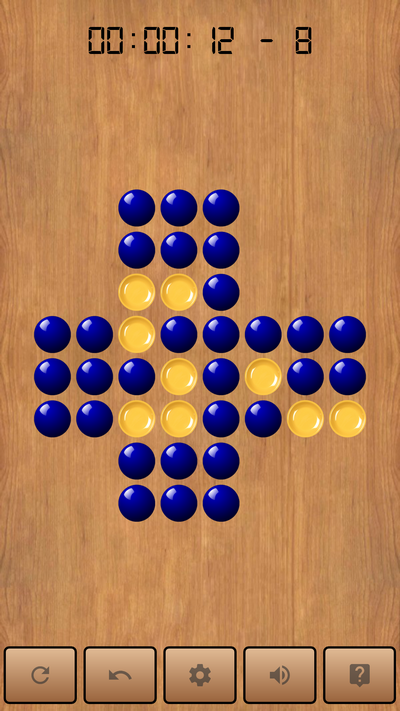


By making horizontal or vertical draughts-like moves (see Figure 1), the pegs are gradually. Pegs are arrangedon the board so that at least one hole remains. In the English version of the game considered here, the board is in the shape of a cross with 33 holes, as presented in Figure 2. Generalized Hi-Q is NP-complete, Trans IEICE 73.Į. Peg Solitaire is played on a board with a number of holes. From the abstract: We solve the problem of one-dimensional peg solitaire. Linear Cellular Automata and the Garden-of-Eden, Mathematical Intelligencer Vol. Peg Solitaire is played by jumping any peg on the board over an adjacent peg. Mathematical Theory of Computation, McGraw-Hill book company. DNA Computing, Matching Systems and Universality, Turku Center for Computer Science, TUCS Technical Report No. Introduction to Automata Theory, Languages and Computation, Addison-Wesley Inc., Reading, Mass. Gardner, Peg Solitaire, in Unexpected Hanging and other Mathematical Diversions, Simon and Schuster, New York. Prefix Grammars: An alternative characterization of regular languages, Information Processing Letters. on Structure in Complexity Theory, IEEE Computer Society Press, Los Alamitos, CA, 1992. Eppstein, One-Dimensional Peg Solitaire, and Duotaire, arXiv:math/0008172, 2000. 1 Introduction Peg solitaire is a game for one player. In particular, we show that the set of congurations that can be reduced to a single peg forms a regular language, and that a linear-time algorithm exists for reducing any conguration to the minimum number of pegs. String Rewriting Systems Springer-Verlag Graduate Texts in Computer Science. We solve the problem of one-dimensional peg solitaire. Groups or stacks of sequenced cards in the tableau can also be moved together on top of a card of the opposite color and higher rank. Ins and Outs of Peg Solitaire, Oxford University Press, Recreations in Mathematics Series. Face up cards in the tableau or stockpile can be moved on top of another face up card in the tableau of an opposite color that is one rank higher, forming a sequence of cards. Winning Ways for Your Mathematical Plays: Vol. Solitaire Cones, Technical Report, School of Computer Science, McGill University.Į.

In particular, we show that the set of configurations that can be reduced to a single peg forms a regular language, and that a linear-time algorithm exists for reducing any configuration to the minimum number of pegs.D. (Cristopher Moore, David Eppstein) - From the abstract: We solve the problem of one-dimensional peg solitaire. It is complemented by his more theoretical Analysis of Peg Solitaire page.

(Jaap Scherphuis) - Jaap's page has a concise, memorable solution to the 32-peg "classic," or "central complement" puzzle, and some enumerative results. If in some row or column two adjacent pegs are next to a hole (as in Figure 1 ), then the peg in can jump over the peg in into the hole in. (John Beasley) I recommend Beasley's out-of-print book The Ins and Outs of Peg Solitaire, but if you can't find it, there is a generous amount of interesting reading on his web page, including more recent writings. Introduction Peg solitaire is a table game which traditionally begins with pegs in every space except for one which is left empty (i.e., a hole). (George Bell) A 2016 paper on computer search for particularly challenging solitaire problems, as well as symmetric ones. (George Bell) This article from Mathematics Magazine is a good place to start reading about the mathematical theory of the game. You might want to start with one of the following articles instead. However, it is so comprehensive that it can be overwhelming.
1 dimensional peg solitaire plus#
George Bell's collection of information about peg solitaire is the ne plus ultra, and his list of references is so extensive that this one is practically redundant. Peg Solitaire is rich in algebraic, combinatorial, and algorithmic theory. The difficulty ratings are subjective, so take them with a grain of salt. The collection aims to be interesting, and well-graded in difficulty, rather than comprehensive. Of the remaining problems, some I drew up by hand, and some were computer-generated. I modeled the graphics here on that version of the game. Perhaps you had the same one, the one with the professorial owl on the box top. Some of the problems in this collection are drawn from the charming New Problems in Puzzle-Peg booklet (copyright 1929) included with the solitaire board I had as a child.


 0 kommentar(er)
0 kommentar(er)
